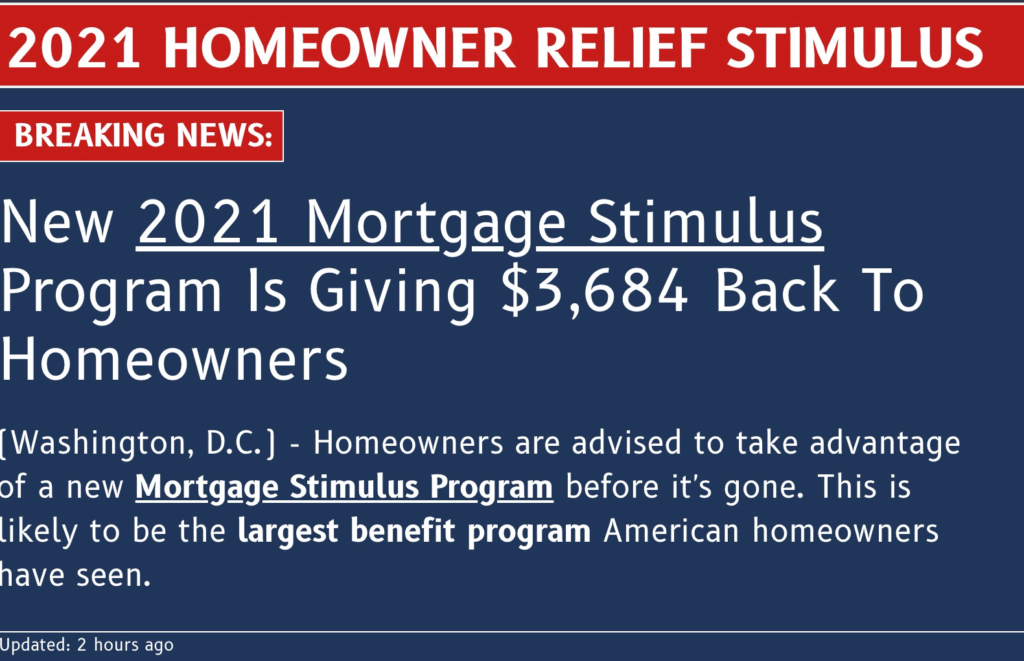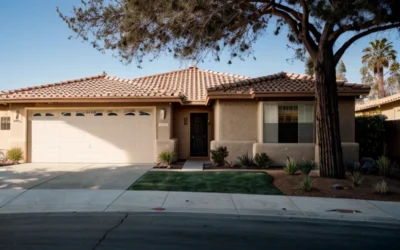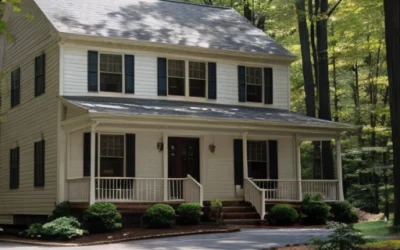The 2021 Mortgage Stimulus Program — Does it Really Exist, How Does it Work and Where do You Get It?
As you can see in this image taken from a website we found recently, some claiming the existence of a “Mortgage Stimulus Program” and sometimes “Covid Relief Programs for Homeowners”. We thought it would be good for our readers to clear up what all this means and if any programs like that really do exist.
We could not find any programs that claim to give homeowners $3,684 so from what we could tell, that is a fabrication or arbitrary number based on an undisclosed unique situation. However, there are many programs out there where you can get relief. We found the best article we could on this subject, with the most information and resource-rich content we could find, and shared it below. Enjoy!
|
Ohio mortgage programs may be able to save you hundreds every month. A new 2024 mortgage may be able to give relief to homeowners. Unfortunately, most Americans will not receive their mortgage benefits because they are not aware of some of these programs. You do not need to pay anything to check how much you could get. |
Update, May 10th 2021: Biden Signs $10 Billion in Mortgage Stimulus Programs
Via The Mortgage Reports
There’s a large list of government-sponsored and private relief programs to help U.S. households affected by COVID-19.
Below are financial aid programs currently available to U.S. homeowners, renters, and those who have recently become unemployed.
Note: The response to COVID-19 is constantly evolving. Programs listed here may change, expire, or be extended. This list is current as of February 10, 2021.
Important deadlines for mortgage relief
Since March 2020, homeowners have had certain protections under the CARES Act.
These measures apply to conforming loans (those backed by Fannie Mae and Freddie Mac) as well as FHA, VA, and USDA-backed loans.
- Foreclosure moratorium: Mortgage companies cannot start foreclosure proceedings against homeowners who are unable to make home loan payments until at least March 31, 2021
- Mortgage payment relief: Homeowners may opt into a forbearance plan, pausing mortgage loan payments for up to 12 months if they are experiencing financial hardship
As of February 9, 2021, borrowers with Freddie Mac or Fannie Mae loans can request an additional 3 months of mortgage forbearance, for up to 15 months total. To be eligible, you must be in a current CARES Act forbearance plan as of February 28, 2021.
Some homeowners with federally-backed loans can also make an initial request for loan forbearance up to February 28, 2021.
However, this may vary by loan type — FHA, VA, or USDA — and by loan servicer. So check with yours to see how much time you have to submit a forbearance request.
Read on to learn more about how loan forbearance works and how to request mortgage relief if you’re experiencing financial hardship.
How to request mortgage relief
Most help will be available only to those who ask for it. And the organization you need to ask — at least, at first — is your loan servicer. That’s the company to which you make your monthly mortgage payments.
Note: Your mortgage servicer is likely not the same company that set up your loan. To find out who your servicer is, check the company name and contact information on your most recent mortgage statement.
You should work with your loan servicer to discover programs that may help you.
Not all types of mortgages offer the same relief, and there may be state or local assistance you can tap.
But don’t rely solely on the knowledge of the agent to whom you speak. Do some research of your own online. You’ll find some links below. And Google could be your friend.
Coronavirus mortgage relief programs
The type of mortgage relief you may be eligible for depends on your loan type and which bank or agency owns your mortgage.
Here are the relief programs currently available for the four major loan programs: conventional, FHA, VA, and USDA.
Mortgage relief for conventional loans (Fannie Mae and Freddie Mac)
Fannie Mae and Freddie Mac were the first to unveil relief programs for those affected by the coronavirus.
Many homeowners don’t realize their mortgages are owned by Fannie or Freddie. You may not have noticed that one of them bought your loan after you closed. But you can easily find out using the lookup tool that each of them provides:
Be sure to use both tools. Either agency could own your mortgage as they own the majority of U.S. home loans.
Providing you agree with your lender on an assistance package, you could be in line for:
- Mortgage forbearance (reduced or no payments) for up to 15 months
- Penalties and late fees waived on issues covered by your forbearance agreement
- No reporting to credit bureaus about late or ‘missing’ loan payments
- Loan modifications that could allow you the same or lower monthly payments when things return to normal
Under the CARES Act, homeowners do not have to prove they’re in financial distress in order to get mortgage relief. That means no extensive documentation.
Homeowners simply have to “claim” they’re going through financial hardship by sending in a hardship letter saying they’ve been affected by COVID-19.
These programs could offer serious help. Just be aware that there are both pros and cons to forbearance.
In particular, understand that any money you don’t pay now will have to be paid later.
You and your mortgage servicer should be absolutely clear about the timing and terms of repayment once your forbearance period ends.
Homeowners protected under the CARES Act are never required to pay back missed payments as a lump sum right when forbearance ends.
Instead, you can usually opt to make larger payments until the missed sum is repaid, or ‘defer’ repayment until your loan is fully paid off or you refinance or sell the home.
Mortgage relief for government-backed loans (FHA, VA, USDA)
Mortgages backed by the federal government are also eligible for loan forbearance. These include:
- FHA loans
- VA loans
- USDA loans
Just like for conventional loans, those with government-backed loans simply have to ask their lender for forbearance and send in a letter stating they’re going through financial hardship as a result of the pandemic.
In this way, government-backed loan holders can get forbearance for up to one year (180 days, plus one extension of 180 days).
Remember, you have to ask for forbearance. It will NOT be automatically applied to any loans. Again, you need to call your mortgage servicer.
Private mortgage relief programs
Even if your mortgage is not government-backed, you may have access to mortgage relief.
Many private mortgage lenders, big and small, have announced help for customers who are financially affected by COVID-19.
The American Bankers Association maintains a list of banks that have announced help for their customers over the pandemic.
Don’t worry if yours isn’t on that list. It may have just neglected to tell the ABA. Call and ask.
When you call or go online, remember the lending industry’s new unofficial slogan: “When people need help, just give them help.”
Foreclosure moratoriums
If your loan is owned by Fannie Mae or Freddie Mac, you are protected from foreclosure until March 31, 2021.
If your loan is backed by the FHA, VA, or USDA, you’re also protected until at least March 31, 2021.
Until that date, the law prohibits lenders and servicers from beginning a judicial or non-judicial foreclosure against you.
What happens after March? There’s no guarantee. But it seems likely consumer protections will continue under the Biden Administration while COVID is still a major concern.
Meanwhile, some states have also introduced their own moratoriums on evictions and foreclosures. And they may outlast federal protections.
Find out if there are eviction bans in your state or city.
Relief programs for renters
Renters have protections during COVID, too, although they’re less robust than the relief programs offered to homeowners.
- Renters cannot be evicted until at least March 31, 2021, if they are behind on payments due to COVID-related financial hardship
- $25 billion in rental assistance will be available through state and local governments to help renters who can’t make payments
To qualify for rent relief, tenants will have to meet certain conditions, including:
- The household can’t make more than 80% of their area’s median income
- Renters must be experiencing financial hardship related to the pandemic
- The renter must be at risk of losing their housing
Since funds will be distributed locally, tenants and landlords hoping to qualify for relief will need to check relief programs operating in their area.
For starters, check this spreadsheet of local housing programs, compiled by the National Low Income Housing Coalition, to find rental assistance programs currently operating in your state or county.
What to do if you’re behind on rent
The National Low Income Housing Coalition has a lookup tool that can help renters find state and local assistance. But you must still keep in touch with your landlord if you’re having trouble paying your rent.
Call your landlord ASAP if the coronavirus means you’re sick, laid off, or otherwise unable to pay your rent.
Remember: If you forestall payments, they’ll likely be due as soon as coronavirus troubles pass. So make sure you and your landlord are clear on two things:
- How to handle missed or late rent payments during the COVID-19 pandemic
- How repayment for missed rent will be handled once the pandemic ends
Get the agreement in writing if possible.
Also, research measures your state has enacted to protect renters and make sure your landlord is aware of those.
Find out if there are eviction bans in your state or city.
State and Federal unemployment assistance
Some states have initiatives to help employers retain workers who’d otherwise be laid off, and to make lives easier for those who have been and are unemployed.
Laid-off workers may be eligible for unemployment income. The amount of unemployment income you’re eligible to receive varies by state.
Visit your state government’s website to see what unemployment assistance is available where you are.
Those who collect state unemployment should also be eligible for an additional $300 per week in federal unemployment income, thanks to a stimulus bill passed in December 2020.
At the time the bill passed, the additional $300 was available for 10 weeks — until March 14.
Additional assistance could be provided via the $1.9 trillion stimulus bill currently being debated in Congress. But as of this writing, the bill has not yet passed, and there’s no guarantee it will.
Mortgage modification scams
Unfortunately, some con merchants see this national emergency as an opportunity rather than a tragedy.
Already, the Consumer Financial Protection Bureau is having to warn Americans about mortgage modification scams. It says:
Scammers may:
- Ask you to pay fees upfront to receive services
- Promise to get you a loan modification
- Ask you to sign over the title to your property
- Ask you to sign papers that you do not understand
- Say you should start making payments to someone other than your servicer or lender
- Tell you to stop making mortgage loan payments altogether
If anyone has made any of these requests or claims, you can report that company by submitting a complaint with the CFPB online or by calling (855) 411-CFPB (2372).
And the Federal Trade Commission reminds us: “The government will not call to ask for your Social Security number, bank account, or credit card number. Anyone who does is a scammer.”
It warns equally against those asking for any form of upfront payment or promising to get you stimulus money quicker than normal. Again, those are scams.
Trustworthy resources for COVID-19 information
The federal government’s website has a portal to numerous sources of information on COVID-19. Better to rely on them than social media or even some media outlets.
Among other things, these resources include:
- CDC COVID-19 information
- Information for seniors and people with disabilities
- Information for Medicare recipients
- Information for Veterans
- Guidance for air travel
- Info about the government’s response to COVID-19
Your state’s website likely has a similar page for local services.
Times are likely to remain hard for many of us. But knowing where we truly stand can make dealing with those easier.
So whether you need mortgage relief or reassurance about health matters, be sure to choose trustworthy sources — and to ask for help as soon as you think you’re going to need it.







Ilike a grant To help with some bills
Biden granted bars and restaurant owners tens of billions. There were almost no conditions. Wall Street corporations were also given an estimated $1.8 Trillion with no conditions. The GAO estimated 20% of the stimulus supports corporate executive as bonus or other advantages.
My exhaustive search indicates there is little or no realistic support for homeowners going forward. The Fannie Mae RefiNow program might be real. Its not a grant.
It only works for the rich. If you actually need help you won’t get it
Hey Doug,
If there is anything specific we can help with please let us know 🙂
-LM
Been trying to get help since the pandemic started haven’t had a full time job In months I guess they’ll help when my house is in foreclosure
So much mumbo jumbo instead of this is where, who to contact for help. Typical bureaucratic red tape BS.
Hey Elon,
Tell me what you need or want specifically and maybe we can help you find it!
Thanks for taking the time.
-Chris S.
The information included in this article is extremely helpful. Thank you for including it in a concise and approachable manner.
You are very welcome!
Sept 2021 most of this is obsolete. The Fannie Mae has a RefiNow program that is months late in launching. For those in Forbearance, Fannie Mae verified that a minimum of 3 Payments must be resumed under the Bank Lender agreement before Fannie Mae will consider the application. For those of us with >4% existing loans, a Refinance at current rates, reusing our existing information is suppose to speed up and offer reduced fees. Beware that Most Lenders will not inform, existing bank loans will not inform about RefiNow. The feeling is they don’t make as large of a commission.
Key: The RefiNow is only good as of today for refinancing under $350,000 if the home equity has around 20%. It isn’t for everyone.
In other news: More evidence that Fannie Mae, Freddie Mac has extreme tightened conditions on approval of Home Mortgages since around July 4th, 2021 for loans over (estimated) $550,000. Home buyers for homes over $650,000 with ample down-payments and perfect credit appear to be rejected. With little or no home mortgage loan approval, these higher end homes do not appear to be selling. This may be in part to fulfill the Federal Reserve statement that housing inflation is temporary. For what ever reason, the home sales the last 90 days reflect this policy that is reported on dozens of professional real-estate blogs.
Watch for scammers searching for desperate homeowners as the Jobs decline. The highly touted “900,000 new jobs” was overwhelmingly part-time no benefits well under $20 an hour. at the same time around 1.1 M first-time full-time employees filed for unemployment insurance. Political news that the job market is growing will not provide details of part-time, no-benefits vs Full-time layoffs.
It is interesting that you say “We could not find any programs that claim to give homeowners $3,684 so from what we could tell, that is a fabrication or arbitrary number based on an undisclosed unique situation.”
But then this article is full of ads for the service.